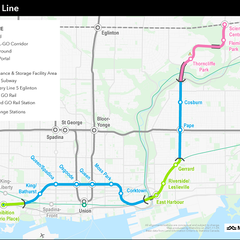Can we also talk about a point that no one is seeming to bring up. If we went with the DRL, the city tend to accidentally build the underground most grand and massive stations, that's what really brings costs up, and I fear the city or ttc won't learn their lesson on building what's necessary. And it's not that Light Metro stations are necessarily more cheap, but Metrolinx is actually building the right things, the necessary station facilities, entrances and above-ground stations are even easier and cheaper.
Also, extending the line from Science Centre, couldn't be easier. You got Don Mills Road; the 25 is the fourth bus busiest route on the TTC. Connections to new developments at Barber Greene, Shops at Don Mills at Lawrence, uhh York Mills bus, plus Fairview Mall, and a quickly developing area. Not to mention even more potential north of Sheppard. With underground subways, you're simply restricted in how many stations you can put because it's expensive.
We can simply provide provisions on aboveground sections so that stations are built,
as necessary so if development does occur, it can be built either publicly or privately but relatively affordable. Developers funded a new station on the Canada Line in Richmond for only 30 Million to support the local development, and reduce car dependency. Plus, when reconfiguring the road, better sidewalks, cycle tracks and streetscaping can be provided.
View attachment 345234
When I visited Vancouver a month ago, I was seriously impressed with the Skytrain. It was super fast, had impressive acceleration from stations, and was eerily quiet, not to mention the amazing views. It went to so many different cities in Metro Vancouver, and building aboveground allowed them to continuously expand the system and building underground where it was right. Reece is right, light metro is a perfect technology for Toronto, and this line is what is necessary to change skeptics minds who'll only want heavy rail subways.
Again, the line and plan isn't perfect, but it's a heck of a good plan. By delaying this plan a lot, or going back to the old plan, will make riders wait even longer and make the line even more expensive, which then risks the line not being built. I really don't want to hear, "let's get this right the first time". That mindset is the difference between other cities quickly bringing transit everywhere, and us, Toronto still stuck with a subpar system because we're still arguing.



















